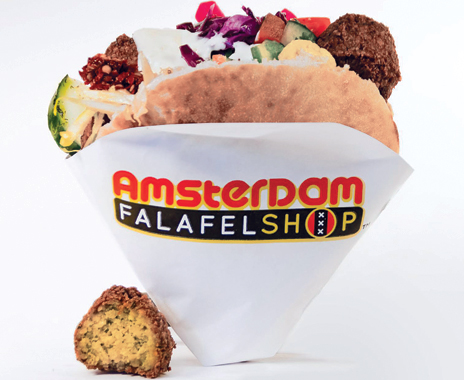Arianne Bennett says her husband, Scott, first tasted a falafel in 1968. He rediscovered the fried chickpea-based product decades later on a trip to Amsterdam, the Netherlands, and when the couple returned home, they decided to develop their own falafel shop with a do-it-yourself toppings bar like the ones they enjoyed in the Dutch city.
The Bennetts opened the first Amsterdam Falafelshop in 2004 in the Adams Morgan neighborhood of Washington, D.C., which is known for its lively nightlife.
“We came back here and got a [Small Business Administration] loan and found a couple of investors and began walking the falafel path,” Bennett says. “It was hard. We’d go to a bank and say we wanted to open a falafel shop and they’d say, ‘What? A waffle shop?’”
Not only did residents and visitors in the nation’s capital embrace falafel, she says, but what began as one hole-in-the-wall place for revelers to get a late-night bite has grown into a seven-store chain, and there’s no end in sight.
Bennett says that as the brand’s reputation spread, people started asking if it would open in other neighborhoods. She and Scott started seeing the potential of the brand.
“We had to make a choice between doing it ourselves or franchising,” Bennett says. “We researched franchising and decided to pick that path.”
The Amsterdam Falafelshop menu is simple: falafel in a pita, falafel in a bowl, fries, and toppings. The combinations, however, are almost endless. Customers can choose a small sandwich with three falafel balls in a pita for about $4.25 or a regular sandwich with five falafel balls for around $5.95. Guests can also choose a bowl—priced by weight—filled with as many falafel balls and toppings as they desire. The entire menu is vegetarian.
“What makes us different is the toppings,” Bennett says. “What our customers get is 22 salads and sauces on an amazing toppings bar.”
Amsterdam Falafelshop
CEO: Arianne Bennett
HQ: Washington, D.C.
YEAR STARTED: 2004
ANNUAL SALES: Undisclosed
TOTAL UNITS: 7
FRANCHISE UNITS:6
There are more than 4,193,000 possible combinations available at Amsterdam Falafelshop. “You can put as many toppings as you want on a sandwich,” she says. “The key is to crush your falafel ball flat and then open your pita and put all the good stuff on it.”
All the toppings are made fresh in house, with the exception of a few imported condiments like pepperoncini. Toppings include tahini, peanut sauce, pickled cabbage, onion sauce, hummus, and numerous vegetable salads.
“For years my husband worked in bars in really good restaurants and was around really great food every day, so his experience with food was that of a foodie,” Bennett says. “We leaned on all of our chef friends and went on trips to Amsterdam with chef friends.”
Eventually the pair hired a chef to tweak recipes. They vetted those recipes and began making spice packets for consistency. As for the falafel itself, Amsterdam Falafelshop soaks, grinds, and marinades the chickpeas in-house.
“Then the cook at the fryer sees a customer walk in and starts frying falafel balls just for him, because there’s nothing else to order,” Bennett says. “So you get hot falafel balls in a warm toasted pita.”
Amsterdam Falafelshop also serves up a popular side: frieten, or Dutch-style fries.
“Dutch fries are fried once, returned to room temperature, and then fried again when ordered,” Bennett says. “This makes them crispy and delicious.” The fries are served with a choice of dipping sauces that include curried ketchup and a peanut sauce.
The tables at Amsterdam Falafelshop were designed to accommodate the uniquely European fries: They have holes in the laminated tops that are sized to hold a paper “fry cone.” The art on the walls also has a European feel.
“Every restaurant is unique,” Bennett says. “All locations have art from or about Amsterdam. The selection of artwork is up to the franchisee.”
In addition to the Washington, D.C., area, Amsterdam Falafelshop has stores in Boston and will soon open a Dallas location. Bennett says there are several U.S. cities the company has targeted for growth and that Amsterdam Falafelshop fits best in a downtown or eclectic urban area with a lot of walking traffic.
While the original location is only 1,200 square feet, typical stores are between 1,500 and 2,000 square feet.
The staff are trained to make combination suggestions to customers.
“For example, we might ask if they like onions or garlic in order to guide them toward sauces and salads they might enjoy,” she says. “We want it to be an experience.”
An experience, she says, that ends with the customer marveling that they had an amazing lunch for $7.










